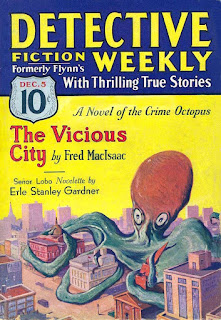The Narrative
 |
| An early pulp magazine, continuing popular characters from the dime novels. |
I’ve contemplated how to make a story out of this. Not a
thriller, as you might expect. I want to create a dime novel of it, a true melodrama in the style of the immensely popular sensationalist novelettes of the 19th and early 20th centuries.
Slumming Authors
The first dime novels, published near the beginning of the
American Civil War, are sensationalist stories also known as "penny dreadfuls." They're small pamphlets, approximately 100 pages, inexpensive, easy to carry and to share with friends. They have simple, formulaic plots focusing on physical descriptions
and concrete pictures. There are no mind games or
psychoanalyses here, just straight ahead storytelling.
 |
| The dime novels were printed in newspapers as serials, then later collected into little books. |
Dime novels were immensely profitable for publishers and even respectable
authors — Louisa May Alcott, Henry Wadsworth
Longfellow, Robert Louis Stevenson, and Alfred Lord Tennyson — contributed to the genre.
There were many popular women dime novelists. Fanny Fern sold 70,000
copies of her book Fern Leaves and 50,000 copies of Ruth Hall. Uncle
Tom's Cabin, by Harriet Beecher Stowe, sold hundreds of thousands of
copies.1
Beautiful Melodrama
According the Merriam-Webster, melodrama is a “a
work characterized by extravagant theatricality and by the predominance of plot
and physical action over characterization.” Dime novels are melodramatic,
sometimes to the point of exhaustion. Escape piles upon escape, chase follows
chase, etc.
 |
| The Argosy was a a very popular magazine in the early years of the 20th Century. |
The news of the world in 2019 cries out for melodramatic
treatment. I imagine a wronged vigilante (or perhaps a bent hero/heroine) delving into the
cesspool and exposing the truth of bribery, corruption, blackmail, human
trafficking, drugs, gangs, and who knows what else.
This is not so far from the dime stories published at the beginning of the 20th Century. Listen...
“In those days the police, as a whole, were corrupt, brutal, heartless; I saw innocent men against whom they had a grudge, or whom they wanted out of the way for some reason, ‘railroaded to gaol’ [jail] on cooked up evidence; sickening and dreadful scenes I witnessed — Tammany had it’s slimy tentacles everywhere and graft was the essence of success in every branch of public life….” – “Alias, the North Wind,” The Cavalier May 10 – 31, 1913 p. 121-122
“In those days the police, as a whole, were corrupt, brutal, heartless; I saw innocent men against whom they had a grudge, or whom they wanted out of the way for some reason, ‘railroaded to gaol’ [jail] on cooked up evidence; sickening and dreadful scenes I witnessed — Tammany had it’s slimy tentacles everywhere and graft was the essence of success in every branch of public life….” – “Alias, the North Wind,” The Cavalier May 10 – 31, 1913 p. 121-122
 |
| The first serialized part of "Alias, The Night Wind" |
Change a few words, make the sentence structure a bit more
modern, add some current events and there you have it — the perfect recipe for a modern melodrama. I see no reason why I shouldn’t write some
new dime novels. It might be fun. Possibly profitable. The material is all there, just look at the headlines any day of
the week. All I need is a good hero/heroine and his/her accomplices.


Excellent article. I cannot wait to read what you come up with!
ReplyDelete